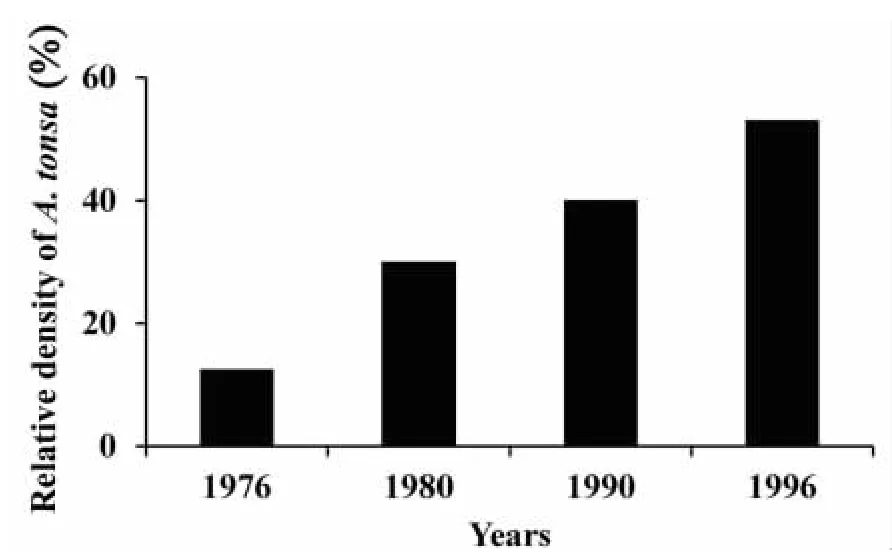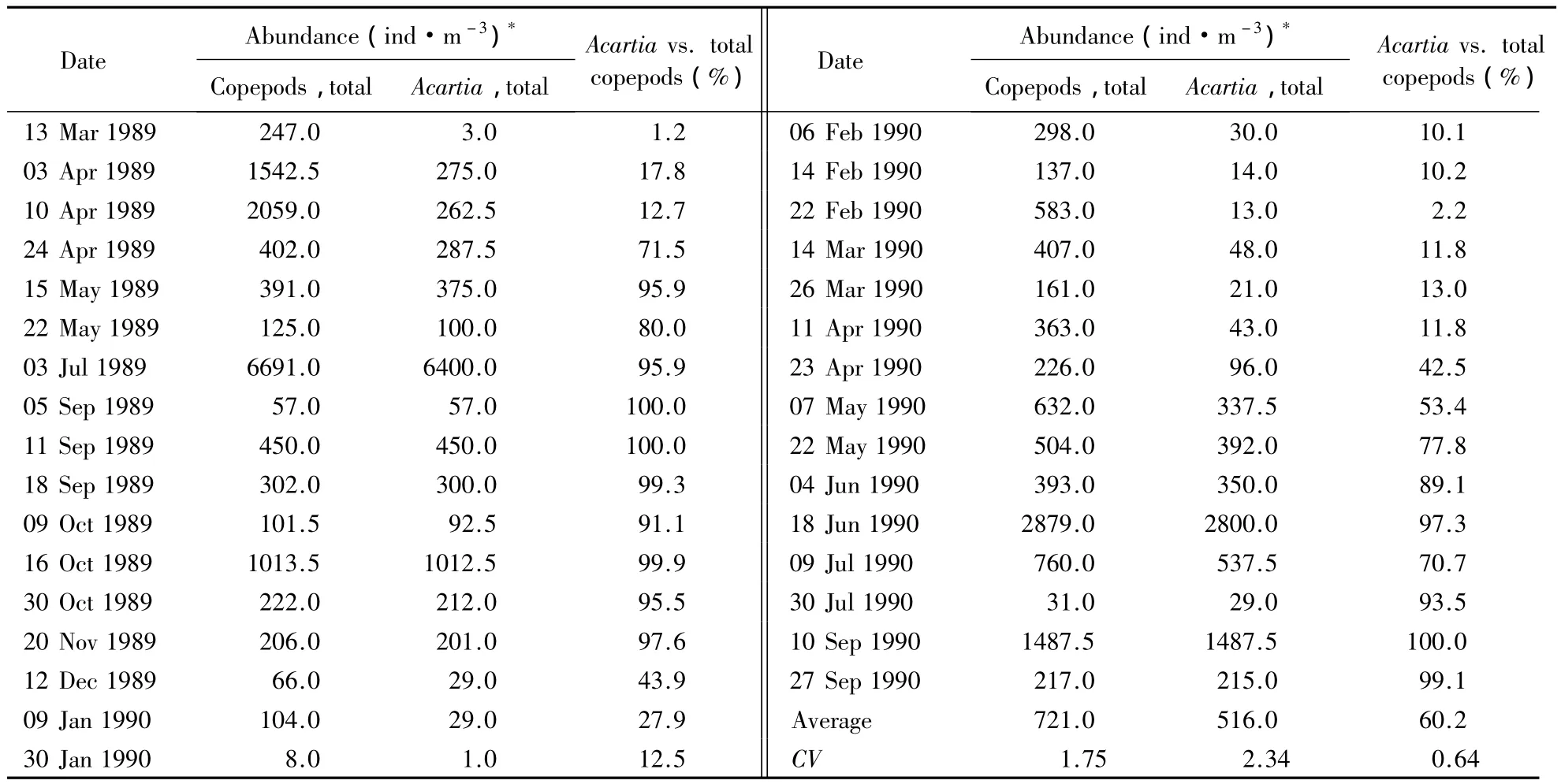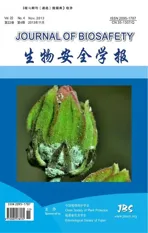Acartia tonsa(Сopepoda)in the Black and Caspian Seas:Review of its success and some lessons
2013-07-05NickolaiShadrin
Nickolai Shadrin
Institute of Biology of Southern Seas,2,Nakhimov Ave.,Sevastopol,99011,Crimea,Ukraine
Introduction
Alien species invasions are now recognized as one of the greatest ecological threats to human well-being(Leppäkoski et al.,2002;MacNeel,2001;Richardson,2011).Alien species often cause enormous damage to biodiversity and the valuable natural ecosystems upon which we depend.Successful alien species can transform the species composition of ecosystems by repressing or excluding native species,either directly or indirectly(Leppäkoski et al.,2002;Richardson,2011).Aliens can also have cascading effects on insect-eating birds and on plants that rely on insects for pollination or seed dispersal.The calculated damage from invasive species worldwide is total more than US$1.4 trillion annually — 5%of the global economy—with impacts across a wide range of sectors(Pimentel et al.,2001).
In past ecosystems changed and evolved in relative isolation;there were slight possibilities of a natural exchange with each other.Early human migration led to the first intentional introductions of alien species.Increase in human migratory movements,as well as flows of goods,directed introduction of exotic species have led to a huge increase in the intensity of anthropogenic transfers of alien species on a global scale(Grigorovich et al.,2002;Leppäkoski et al.,2002;Richardson,2011).It is therefore not surprising that human-induced transfer of exotic species considered as the main reason for the growth of invasions at a global level.Based on this paradigm,we try to understand and explain current invasions,predicting new the possibility of invasions,to develop management approaches to mitigate the unwanted invasions and their results.To develop a scientific background of environmental management for preventing and mitigating damages from alien species we need to extract and analyze the lessons from the different seas.The Black sea gives us a lot of such lessons(Leppäkoski et al.,2002;Shadrin,2000).
The Black Sea is a sea in south-eastern Europe(Zaitsev,2008),surrounded by dryland of Europe,Anatolia and the Caucasus.The sea is ultimately connected to the Atlantic Ocean via the Mediterranean and the Aegean Seas and various straits.The Black Sea is the world's largest meromictic basin where the deep waters have a very limited mixing with the upper layers of oxygenated waters,as a result,over 90%of the Black Sea volume is anoxic waters(Zaitsev,2008).The sea area is 436400 km2.22 countries are entirely or partly located in the catchment area of the Black Sea,and more than 170 million humans live within this area of 2.3 mln·km-2(UNDP,1997,2007).The ratio of the catchment basin surface to the surface of a recipient water body,the so-called specific catchment for the Black Sea SC>5;which is a very high value.This indicates a high anthropogenic impact on the Black Sea ecosystem.A high anthropogenic impact disturbs the ecosystem and promotes to open a door for invasive species;currently more than hundred alien species were recorded in the Black Sea(Grigorovich et al.,2002;Shadrin,2000).Some of those had the catastrophic effects on the Black Sea ecosystem and human activities(Leppäkoski et al.,2002;Shadrin,2000;Shadrin et al.,2012).
The Caspian is variously classed as the world's largest lake or a full-fledged sea(Kosarev&Yablonskaya,1994).It is situated where the South-Eastern Europe meets the Asian continent,between latitudes 47°07'N and 36°33'N and longitudes 45°43'E and 54°20'E.It is approximately 1030 km long and its width ranges from 435 km to a minimum of 196 km.It has no connection to the world's oceans and its surface level at the moment is around — 26.5 m below MSL.At this level,its total coastline is some 7000 km in length and its surface area is 386400 km2.The water volume of the lake is about 78700 km3.The water of the Caspian Sea is slightly saline;if we compare the Caspian water with oceanic water,it contains 3 times less salt.The Caspian Sea is a remnant of the ancient ocean,Tethys,more precisely of its Paratethys Bay.About 50~60 million years ago the Tethys Ocean connected the Atlantic and the Pacific Oceans.However,due to gradual shift of continental platforms it lost its connection with the Pacific Ocean and later on with the Atlantic Ocean.As a result,the water body became isolated.Today the Black and Caspian Seas are connected by Volga-Don Chanel.There are a lot of alien species in the Caspian Sea and almost all of them reached it via the Black Sea(Grigorovich et al.,2002;Leppäkoski et al.,2002;Shadrin,2000).
Acartia tonsa invasion in the Black Sea
The copepod A.tonsa Dana,1846 was first found and described as a specific morphotype of A.clausi Giesbrecht,1889(A-form)from 1976 ~ 1989 year samples taken in the Sevastopol Bay(the Black Sea)(Popova & Shadrin,1992;Shadrin & Popova,1994).Later,A.tonsa was identified from samples near Karadag(SW Crimea)(Belmonte et al.,1994).Description of the A-form of A.clausi was based on morphological features that have not been used in the key for identification of copepods;in 1997,the misidentification was realized.The same mistake was made for the Caspian Sea specimens(Prusova et al.,2002).
Because A.tonsa and A.clausi were not separately identified in the Black Sea before the late 1990s,we only have long-term data on A.tonsa for Sevastopol Bay(Shadrin et al.,1999).
A.tonsa was absent in samples taken in 1968.By the next sampling,1976 it was rather abundant.Unfortunately no samples were taken between these two dates.A.clausi is present year round whereas A.tonsa occurs only from May/June to October/January(Sazhina& Shadrin,1993).In 1989~1996 A.clausi was absent in 22% ~38%of summer samples.In 1976,20%of the samples had more than 50%individuals of A.tonsa.In 1989 ~1990,during a period when A.tonsa and A.clausi jointly occurred,A.tonsa clearly prevailed in about 50% of samples;it was 90% ~100%of the total density of both species.
In 1976 there were four Acartia species present in Sevastolpol Bay:A.clausi,A.tonsa,A.(Paracartia)latisetosa(Kritchagin,1873)and A.margalefi Alcaraz,1976.A.margalefi at that time was identified as small form of A.clausi.The total numbers of all Acartia spp.was 27% ~28%of the total density of Copepoda(Prusova& Shadrin,1983).A.margalefi was dominant(Table 1,Fig.1).A.latisetosa decreased after 1954,and after 1976,neither A.latisetosa nor A.margalefi were present.

Table 1 Total abundance of all copepods and Acartia spp.in the Sevastopol Bay,Black Sea,in 1976(data from Prusova & Shadrin,1983)

Fig.1 Long-term changes of average year%of A.tonsa in total Copepoda density(the Sevastopol Bay)
From 1976 to 1996,A.tonsa density increased:it was 37%in 1976;70%in 1989 ~1990 and 88.5%in 1995~1996.This was paralleled with an increase of Acartia spp.in all Copepoda:14%(1954);27%(1976);46%(1979~1980);60%(1989~1990)and 62%(1995 ~1996)(Petipa,1959;Shadrin et al.,1999).Changes,which occurred between 1954 and 1976,show that the introductions of A.tonsa and ctenophore Mnemiopsis leidyi A.Agassiz,1865 are not the only reasons of the decline of Copepoda taxocene in the Sevastopol Bay.The ecosystem destabilization due to anthropogenic impact on the Bay may also have had an impact(Shadrin,2000).
After 1976 the intra-annual variability of densities in Acartia species as well as of whole copepod taxocene increased(Table 2).Changes in the character of variability may be early-warning signals of a system drift to tipping points at which a sudden shift to a contrasting dynamical state may occur(Scheffer et al.,2009)and indicate a destabilization in copepod taxocene and Acartia spp.populations.This increase was accompanied by a decrease in total copepod density and an increase in the relative contribution of Acartia to the total copepod density(Tables 1,Table 3~4).In 1999~2000 some samples were collected from Sevastopol Bay without any Copepoda,indicating a local collapse of copepods.In the summer of 1998,the mesozooplankton of the Sevastopol Bay was dominated by two alien species— A.tonsa and the cirripede Balanus(Amphibalanus)improvisus(Darwin,1854)(Pavlova & Kemp,1999).

Table 2 Interannual coefficient of variation of some density parameters of Copepoda in the Sevastopol Bay,between 1976~1996

Table 3 Total abundance of all copepods and Acartia spp.in the Sevastopol Bay,Black Sea,in 1989~1990(data from Popova& Shadrin,1992)

Table 4 Total abundance of all copepods and Acartia spp.in the Sevastopol Bay,Black Sea,in 1995 ~ 1996(data from Shadrin et al.,1999)
Currently A.tonsa occupies all the Black Sea area including its closed and semi-closed lagoons,with salinity to 55 ppt,(Shadrin & Anufriieva,2013),and the Azov Sea including Sivash Bay(Prusova et al.,2002;Zagotodnyaya et al.,2008).Analyzing changes in the Black Sea zooplankton many authors blame on M.leidyi(Finenko et al.,2003;Gubanova et al.,2001;Murina et al.,2003).Considering the vigorous invasion by A.tonsa,it seems those two new-comers have jointly influenced the zooplankton community.
A.tonsa,making its own niche,uses many of the resources previously used by A.latisetosa.These two species are very similar in size and ecological requirements.However,the degradation of the A.latisetosa population began a long time before the introduction of A.tonsa(1976)and M.leidyi(1986)into the Black Sea.A.latisetosa and A.margalefi had vanished from Sevastopol Bay before the introduction of M.leidyi but several years after the introduction of A.tonsa.Possibly the main reason was sediment pollution,damaging the obligatory resting egg-stage of the original,native species(Shadrin et al.,1999).Resting stage cannot survive in hard polluted sediments.A.tonsa also has resting eggs while A.clausi has not(Sazhina &Shadrin,1993).
A comparison of A.tonsa and M.leidyi impacts on native zooplankton enables the conclusion that A.tonsa is mostly responsible for the changes in composition of copepod taxocene while M.leidyi is responsible for the drastic decrease of total copepod abundance.A competing alien invader influences the diversity of closely related species,but a predatory invader decreases the total density of its prey.A.tonsa and M.leidyi impacts transformed the Black Sea pelagic ecosystem to an alternative stable state.In the period 2001 ~2008,a new alien copepod Oithona davisae Ferrari and Orsi,1984(Gubanova& Altukhov,2007;Temnykh &Nishida,2012;Zagorodnyaya,2002),became abundant and another transition started.
A.tonsa in the Caspian Sea
The article reporting A.clausi in the Caspian Sea(Kurashova & Abdullaeva,1984)included pictures that more closely correspond to A.tonsa than A.clausi.We checked the samples taken in 1986 in the North and Central part of the Caspian Sea(kindly sent to us by Dr.Kurashova),and all specimens were identified as A.tonsa(Prusova et al.,2002).
The history of the A.tonsa invasion into the Caspian Sea was given by several articles(e.g.Kurashova & Abdullaeva,1984;Tinenkova et al.,2000),except that these articles refer to it(erroneously)as A.clausi(Prusova et al.,2002).In 1979 a single specimen of Acartia sp.was found in the Volga-Don Channel.In August 1981,several more individuals were sampled in the eastern part of the southern Caspian Sea.By August 1982,all life stages of A.tonsa were very abundant in the Central Caspian Sea(up to 30000 ind·m-3).In 1983,A.tonsa had reached the Northern Caspian Sea,and by 1998,the species occupied the whole Caspian Sea including deepwater zones(where it reached 264 ind·m-3)and hypersaline areas.Since 1986 A.tonsa is the dominant copepod in the Southern Caspian Sea(more 3000 ind·m-3).It outcompeted a formerly dominant copepod Eurytemora grimmi(Sars G O,1897)(whose density was about 2000 ind·m-3before the introduction of A.tonsa,and 800 ind·m-3thereafter).Calanipeda aquaedulcis Kritchagin,1873 was a dominant copepod in the central part of the Caspian Sea.From 1981(start of invasion of A.tonsa)C.aquaedulcis decreased in density,from a—200~600 ind·m-3in 1971~1981,to— 58~340 ind·m-3in 1982~1993(Tatarintseva et al.,2000).In the Caspian as well as the Black Sea,A.tonsa was increasing in density approximately with same rate(Table 5).

Table 5 Changes of some average summer characteristics of A.tonsa population in the Caspian Sea(data from Prusova et al.,2002;Tatarintseva et al.,2000)
From the Black Sea,A.tonsa also spread into the Marmara Sea between 1980 and 1990 and it is abundant there,especially near the entrance into the Bosphorus Channel(Zagorodnyaya et al.,2000).A.tonsa was introduced through the Black Sea into the Mediterranean Sea as well(Farabegolli et al.,1989).
Morphological changes of A.tonsa in the Ponto-Caspian Basin
After introduction into the Black and Caspian Seas,individuals of A.tonsa became smaller.In the native area,A.tonsa male body length is 1.0 ~1.3 mm and that of females is 1.3 ~ 1.5 mm(Steuer,1926).In this area,where A.tonsa and A.clausi coexist,A.tonsa is longer than A.clausi(Conover,1956).In the Sevastopol region A.tonsa became smaller:females were 1.09 mm in 1976 and 0.9 mm in 1995 ~ 1996,significant(P=0.001)reduction.Comparable trends exist for male of A.tonsa in samples taken in the summer 1990 near Karadag(ES Crimea)(Belmonte et al.,1994).In the Caspian Sea A.tonsa became smaller as well.In 1982 A.tonsa females had a body length of 0.900 ~ 0.975 mm,males — 0.750 ~ 0.850 mm(Kurachova & Abdullaeva,1984).In 1986 A.tonsa females were 0.72 ~0.94 mm long,and males 0.71 ~0.82 mm(Prusova et al.,2002).
In Sevastopol Bay,there was a step by step divergence in size between the two Acartia species and as a result there was a decrease in competition between these species(Table 6).It is important to note that the alien species caused this change in ratio.Many non-native species in the Black Sea underwent morphological modifications(Shadrin,2000)and if a changed alien will come back in natural areal we can talk about"boomerang"invasion which may be more dangerous one than direct invasion(Shadrin,2000).We don't know"boomerang"invasions among aquatic organisms now but some terrestrial changed aliens came back in native areal and led to drastic changes in former native communities(Brasier& Buck,2001).

Table 6 Seasonal relative densities and sizes of A.clausi and A.tonsa in the Sevastopol Bay,Black Sea,in 1995 ~ 1996(data from Shadrin et al.,1999)
Belmonte G,Mazzocihi M G,Prusova I Yu and Shadrin N V.1994.Acartia tonsa:a species new for the Black Sea fauna.Hydrobiologia,292/293:9-15.
Brasier C M and Buck K W.2001.Rapid evolutionary changes in a globally invading fungal pathogen(Dutch elm disease).Biological Invasions,3:223-233.
Brylinski J M.1981.Report on the presence of Acartia tonsa Dana(Copepoda)in the harbor of Dunkirk(France)and its geographical distribution in Europe.Journal of Plankton Research,3:255-260.
Conover R J.1956.Oceanography of Long Island sound,1952 ~1954.Vl.Biology of Acartia clausi and Acartia tonsa.Bulletin of the Bingham Oceanographic Collection,15:156-233.
Farabegolli A,Ferrary I,Manzoni C and Pugneti A.1989.Prima Segnalazione nel mare Adriatico del copepoda calanoide Acartia tonsa.Nova Thalassia,10:207-208.
Finenko G A,Romanova Z A,Abolmasova G I,Anninsky B E,Svetlichny L S,Hubareva E S,Bat L and Kideys A E.2003.Population dynamics,ingestion,growth and reproduction rates of the invader Beroe ovata and its impact on plankton community in Sevastopol Bay,the Black Sea.Journal of Plankton Research,25:539-549.
Grigorovich I A,MacIsaac H J,Shadrin N V and Mills E L.2002.Patterns and mechanisms of aquatic invertebrate introductions in the Ponto-Caspian region.Canadian Journal of Fisheries and Aquatic Sciences,59:1189-1208.
Gubanova A D,Prusova I Y,Niermann U,Shadrin N V and Polikarpov I G.2001.Dramatic change in the copepod community in Sevastopol Bay(Black Sea)during two decades(1976~1996).Senckenbergiana Maritima,31(1):17-27.
Gubanova A and Altukhov D.2007.Establishment of Oithona brevicornis Giesbrecht,1892(Copepoda:Cyclopoida)in the Black Sea.Aquatic Invasions,2:407-410.
Kosarev A N and Yablonskaya E A.1994.The Caspian Sea.The Hague,SPB.
Kurachova E A and Abdullaeva N M.1984.Acartia clausi(Calanoida,Acartiidae)in the Caspian Sea.Zoologicheskii Zhurnal,63:931-933(in Russian).
Leppäkoski E,Gollasch S and Olenin S.2002.Invasive Aquatic Species of Europe:Distribution,Impacts and Management.Dordrecht,Kluwer/Kluwer Academic.
MacNeel J A.2001.The Great Reshuffling:Human Dimensions of Invasive Alien Species.IUCN.
Murina G V V,Shmeleva A A and Lisitskaya Ye V.2003.Annual monitoring of mero-and holoplankton in the oceanarium of Sevastopol Bay.Hydrobiological Journal,39(2):DOI:10.1615/HydrobJ.v39.i2.
Pavlova E V and Kemp R B.1999.Impact of antropogenic load on the summer mesozooplankton in the Sevastopol Bay∥Pavlova E V and Shadrin N V.Sevastopol Water Area and Coast:Ecosystem Processes and Services for Human Society.Sevastopol,Aquavita,142-146(in Russian).
Petipa T S.1959.Feeding of Acartia clausi Giesbr and Acartia latisetosa Kritcz.in the Black Sea.Trudy Sevastopolskoi Biostantsii,12:130-152(in Russian).
Pimentel D,McNair S,Janecka J,Wightman J,Simmonds C,O'Connell C,Wong E,Russel L,Zern J,Aquino T and Tsomondo T.2001.Economic and environmental threats of alien plant,animal,and microbe invasions.Agriculture Ecosystems and Environment,84:1-20.
Popova E V and Shadrin N V.1992.About phenotic heterogeneity of Acartia clausi Copepoda,Calanoida females(large form)in the Sevastopol Bay(Black Sea).Zoologicheskii Zhurnal,71:139-141(in Russian).
Prusova I Yu and Shadrin N V.1983.Seasonal changes in the number and size of two Acartia clausi Giesbr.forms in the Sevastopol Bay.Ekologiya Morya,15:17-19(in Russian).
Prusova I Yu,Gubanova A D,Shadrin N V,Kurashova E K and Tinenkova D Ch.2002.Acartia tonsa Dana(Copepoda,Calanoida)in the Caspian and Azov Seas:morphological description in comparison with Acartia clausi Giesbrecht.Vestnik Zoologii,36:65-68(in Russian).
Richardson D M.2011.Fifty Years of Invasion Ecology:The Legacy of Charles Elton.John Wiley& Sons.
Sazhina L I and Shadrin N V.1993.The diversity of egg types is a mechanism of population preservation in different environmental conditions∥Aldrich J.Quantified Phenotypic Responses in Morphology and Physiology:Proc.27 European Marine Biology Symp.,(Dublin,Ireland,7 ~ 11th Sept.,1992).Ashford,169-173.
Scheffer M,Bascompte J and Brock W A.2009.Early-warning signals for critical transitions.Nature,461:53-59.
Shadrin N V.2000.The species introducers in the Black Sea and in the Sea of Azov:the causes and the consequences∥Matishov G G.Species Introducers in the European Seas in Russia.Apatity,79-90(in Russian).
Shadrin N V,Gubanova A D and Popova E V.1999.Long-term changes of Acartia(Copepoda)taxocene in the Sevastopol Bay∥Pavlova E V and Shadrin N V.Sevastopol Water Area and Coast:Ecosystem Processes and Services for Human Society.Sevastopol,Aquavita,159-167(in Russian).
Shadrin N V,Mironov S S and Ferat T A.2012.Interrelations between the losses of sandy beaches and biodiversity in seas:Case of the Bakalskaya Spit(Crimea,Ukraine,Black sea).Turkish Journal of Fisheries and Aquatic Sciences,12:411-415.
Shadrin N V and Popova E V.1994.Variability of Acartia clausi in the Black Sea.Hydrobiologia,292/293:179-184.
Shadrin N V and Anufriieva E V.2013.Climate change impact on the Marine Lakes and their Crustaceans:The case of Marine Hypersaline Lake Bakalskoye(Ukraine).Turkish Journal of Fisheries and Aquatic Sciences,13:603-611.
Steuer A.1923.Bausteine zu einer Monographie der Copepoden Gattung Acartia.Arbeit of Zoolological Institute of University Innsbruck,1:91-144.
Tatarintseva A A,Ardabieva A G,Terletskay O V,Tinenkova D Kh,Malinovskaya L V,Tarasova L I and Petrenko E L.2000.The Mediterranean introducers in the plankton and Bottom fauna of the Caspian Sea∥Matishov G G.Species-introducers in the European Seas in Russia.Apatity,169-183(in Russian).
Temnykh A and Nishida S.2012.New record of the planktonic copepod Oithona davisae Ferrari and Orsi in the Black Sea with notes on the identity of"Oithona brevicornis".Aquatic Invasions,7:425-431.
Tinenkova D X,Tarasova L I and Petrenko E L.2000.Distribution of alien Acartia clausi in the Caspian Sea∥Matishov G G.Species Introducers in the European Seas in Russia.Apatity,89-91(in Russian).
UNDP.1997.Black Sea Transboundary Diagnostic Analysis.U-nited Nations Development Programme,New York.
UNDP.2007.Black Sea Transboundary Diagnostic Analysis.http:∥iwlearn.net/iw-projects/1580/2263/reports/black-seatransboundary-diagnostic-analysis-2007/at_download/file.
Zagorodnyaya Y A.2002.Oithona brevicornis in the Sevastopol Bay:Is it a single event of a new invader in the Black Sea fauna?Morskoy Ekologicheskiy Zhurnal,2:43(in Russian).
Zagorodnyaya Yu A,Batogova E A and Shadrin N V.2008.Long-term transformation of zooplankton in the hypersaline lake Bakalskoe(Crimea)under salinity fluctuations.Morskoy Ekologicheskiy Zhurnal,7:41-50(in Russian).
Zagorodnyaya Yu A,Kovalev A V and Piontkovsky S A.2000.Influence of water exchange through the Bosphorus on zooplankton distribution in adjacent regions∥Oceanography of the Eastern Mediterranean and Black Sea.Scientific report,Loxemborg,154.
Zaitsev Yu P.2008.An Introduction to the Black Sea Ecology.Odessa,Smil Edition and Publishing Agency Ltd.
